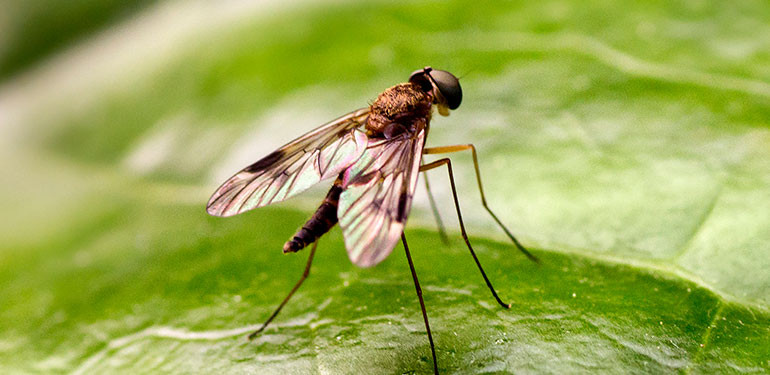Flies are a common annoyance, buzzing around our homes and yards. But they are more than just pests. These insects play crucial ecological roles, from pollinating plants to decomposing organic matter and serving as a food source for various animals. However, their most notable trait, especially when they invade our living spaces, is their rapid multiplication rate. Let’s delve into just how quickly flies can multiply and why this rapid reproduction can lead to significant infestations.
The Astonishing Speed of Fly Reproduction
Logo of the SC Johnson Institute of Insect Science for Family Health, a source of expertise on flies and family health.
If you’ve ever experienced a sudden surge in the fly population in your home, you’ve witnessed firsthand how fast flies can multiply. This rapid increase is due to their incredibly short life cycle and high egg-laying capacity. Take fruit flies, for example. A single female fruit fly is capable of laying approximately 500 eggs throughout her relatively short lifespan. What’s even more impressive is the speed of their development. From egg to adult, the entire life cycle of a fruit fly can be completed in about a week.
House flies are equally prolific. A single female house fly can lay up to 500 eggs in just three to four days and can repeat this cycle multiple times during her life. While house flies typically live for 15 to 25 days, they can survive for up to two months under ideal conditions. Imagine the exponential growth potential when each female fly can produce hundreds of offspring in a matter of days, and those offspring mature and reproduce just as quickly. This rapid reproductive rate is the primary reason why fly infestations can escalate so rapidly and become challenging to control.
Flies as Vectors of Disease
One of the most significant concerns associated with flies is their ability to spread diseases. House flies, in particular, are notorious for their unsanitary habits. They commonly feed and lay eggs on feces, garbage, decaying animals, and other filthy materials. Consequently, they can easily pick up and transfer disease-causing microbes to humans, household surfaces, and food left exposed.
Symbol representing the SC Johnson Institute of Insect Science for Family Health and their dedication to insect science.
The common house fly is suspected of transmitting at least 65 different diseases to humans. These diseases include serious illnesses such as dysentery, diarrhea, cholera, typhoid fever, leprosy, anthrax, tularemia, tuberculosis, yaws, and poliomyelitis. The rapid multiplication of flies exacerbates this problem, as a larger fly population means a greater potential for disease transmission.
Unique Fly Feeding Habits
Flies possess unique feeding mechanisms that contribute to their role as potential disease vectors. Unlike many insects, house flies lack mouthparts for chewing solid food. Instead, they regurgitate enzymes onto solid food to liquefy it, allowing them to consume it. This process of “liquid feeding” can further contaminate food sources as they are essentially pre-digesting food with potentially contaminated saliva.
Adding to their unusual biology, flies taste with their feet. Sensors located on their tarsi, or feet, enable them to determine the palatability of a food source simply by landing on it. This means that flies are constantly sampling surfaces with their feet, potentially picking up and depositing pathogens wherever they go.
Flies’ Role in the Ecosystem and Forensics
Despite their negative aspects, flies are not without ecological value. Carrion flies, such as blow flies and flesh flies, play a crucial role in decomposition. They lay their eggs in dead animal carcasses, and their maggots feed on the decaying tissue, breaking it down and releasing nutrients back into the soil. This process is essential for nutrient cycling in ecosystems.
 A close-up of a midge (fly) on a leaf.
A close-up of a midge (fly) on a leaf.
Furthermore, flies are valuable tools in forensic science. The first documented use of flies in criminal investigations dates back to 13th-century China. Forensic entomologists study fly populations and their larval stages found at crime scenes to estimate the time of death in cases involving corpses. House flies, blow flies, and flesh flies are particularly useful in these investigations.
Pollination and Size Diversity in Flies
Interestingly, some fly species are important pollinators. Species like bee flies, hoverflies, and midges pollinate a variety of plants, especially those that are not attractive to bees. Midges, in particular, are the primary pollinators of the cacao tree, which is essential for chocolate production.
Flies also exhibit remarkable size diversity. The world’s largest fly, the timber fly, can grow up to 8 centimeters (3.15 inches) long. These large flies inhabit Central and South America and lay their eggs in dying trees. Despite their size, timber flies are harmless.
Controlling Fly Infestations
While flies have ecological and scientific significance, their rapid multiplication and potential to spread disease make controlling fly infestations around homes important. Understanding how quickly flies multiply highlights the need for effective fly prevention and control strategies. Taking steps to eliminate breeding grounds, such as proper waste management and sanitation, is crucial.
Don’t let flies take over your space. By understanding their rapid reproduction rate and taking proactive measures, you can effectively manage fly populations and protect your home and family from these pests.